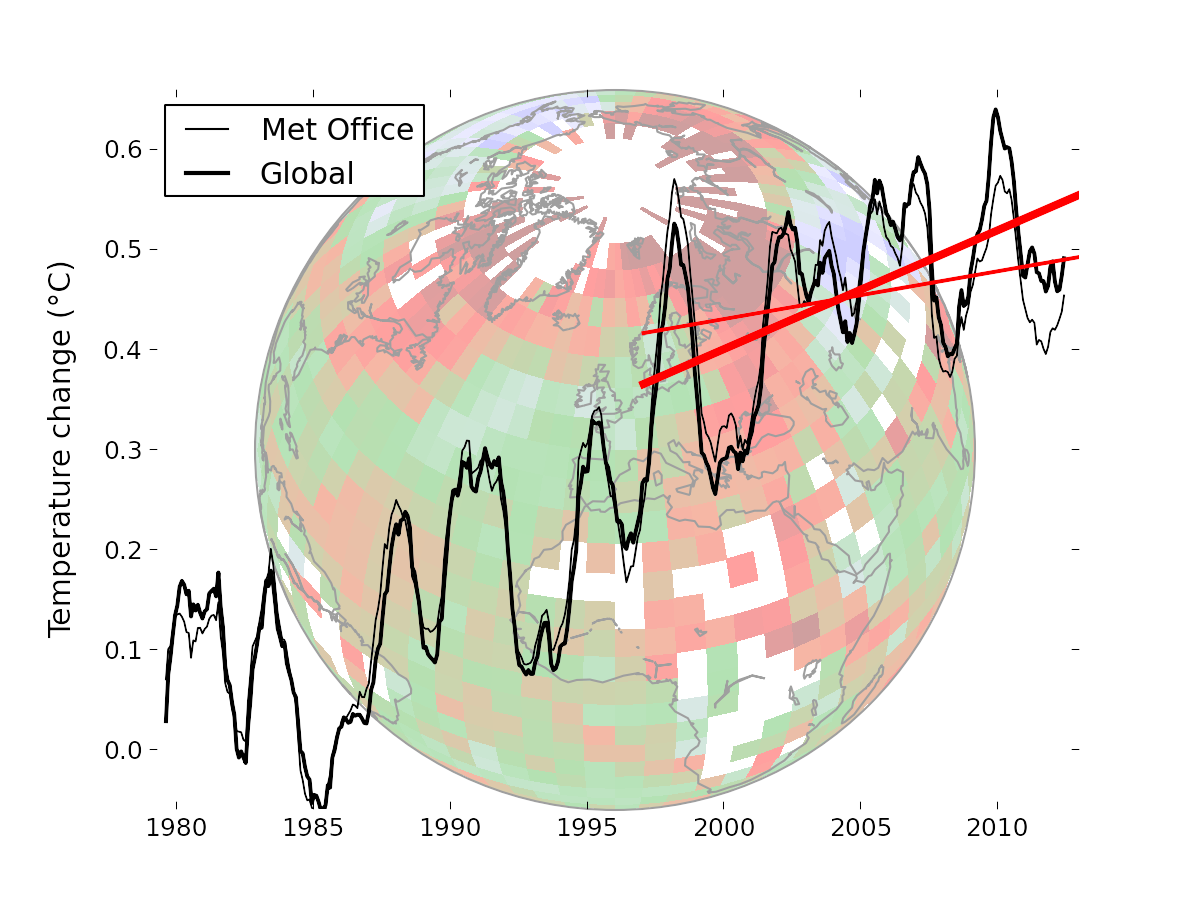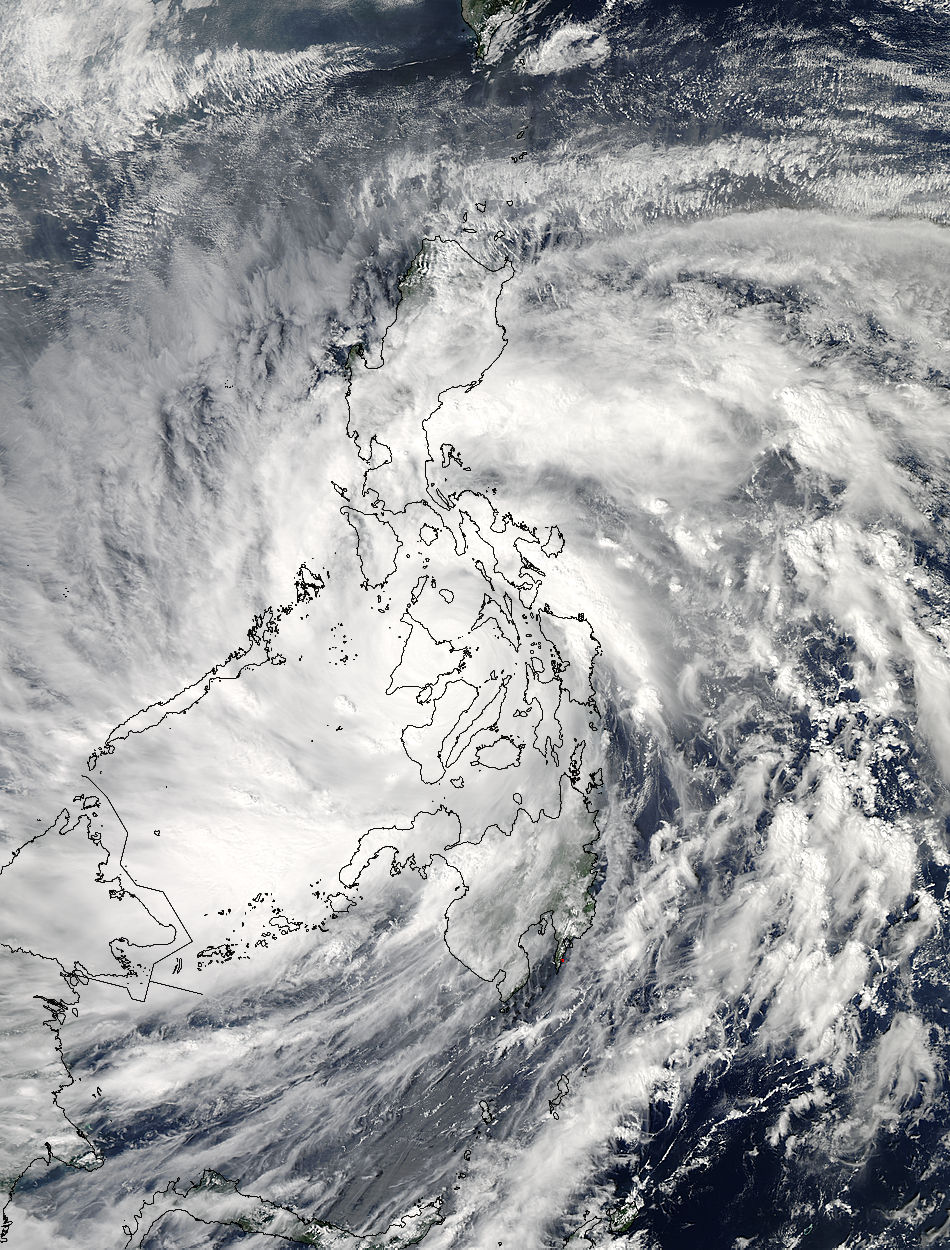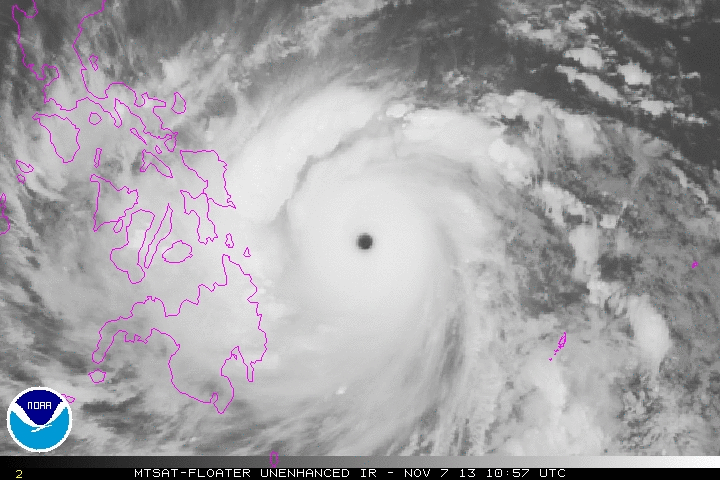Nov. 8, 2013: Super Typhoon Haiyan; Nov. 13, 2013: There is no Pause in Global Warming – Part III; Bjorn Lomborg: Oops he did it again!
Cowtan & Way 2013
Nov. 8, 2013: Super Typhoon Haiyan
After Hurricane Katrina, there was some discussion of establishing a new category for hurricanes. Typhoons (Western Pacific) and Cyclones (Indian Ocean region) are the same as hurricanes, as the names only indicate the region in which the storms are occurring.
The Saffir-Simpson scale is generally based on damage potential rather than wind speeds, though wind, rain, and other factors are included in the estimations. This is not a solid approach as infrastructure hardening could potentially alter the damage potentials of certain storm factors.
An interesting consideration for a new category of storm on the Saffir-Simpson scale would be the limitation in Category five of survivability of concrete and steel structures. An analysis of the destructive capacity of Typhoon Haiyan may well contribute to this discussion with regard to impact on concrete and steel structures and destruction range from the shoreline or storm center.
One thing is evident: warmer oceans due to global warming, and the fact that hurricanes, typhoons, and cyclone strength is determined to a strong degree by the amount of heat provided at the ocean surface provides the basis for discussion of how such storms should be categorized. The possibility of a new category such as ‘Category 6’ is yet to be decided but would likely have a significant proportional increase in wind-speed and related factors over and above ‘Category 5’ on the Saffir-Simpson scale.
The wind speeds for Typhoon Haiyan were exceptional, placing it in the category of ‘one’ of the strongest storms ever recorded in modern history.
NASA reports on Haiyan wind speeds:
Update #1 – Nov. 08, 2013 – NASA Sees Super-Typhoon Haiyan Maintain Strength Crossing Philippines
As Super-Typhoon Haiyan moved over the central Philippines on Nov. 8 at 05:10 UTC/12:10 a.m. EDT, the MODIS instrument aboard NASA’s Aqua satellite captured this visible image.
Super-Typhoon Haiyan slammed into the eastern Philippines as the strongest tropical cyclone of the year, and as of Nov. 8, 2013, was exiting the country and moving into the South China Sea. NASA’s Aqua satellite captured visible and infrared data of Haiyan after it made landfall near Leyete, identifying the extent of its power.
The U.S. Navy’s Joint Typhoon Warning Center noted that just before Super-Typhoon Haiyan made landfall its maximum sustained winds were 314 kph/195 mph, with gusts up to 379 kph/235 mph. PAGASA, the Philippines Weather organization noted that Haiyan’s maximum sustained winds at landfall were near 234 kph/145 mph.
The storm is clearly in the top level of estimates for storm strength (314 kph/195 mph). Hurricane Katrina’s highest winds were estimated at 280kph (174 mph).
Haiyan made landfall as an extremely powerful super typhoon, perhaps the strongest ever recorded at landfall, with sustained winds estimated at 195 mph (315 kph) by the Joint Typhoon Warning Center. Previously, Hurricane Camille, which struck the northern Gulf Coast in 1969, held the record with 190 mph (305 kph) sustained winds at landfall. After striking Samar, Haiyan quickly crossed Leyte Gulf and the island of Leyte as it cut through the central Philippines.
Nov. 13, 2013: There is no Pause in Global Warming – Part III
The science of global warming continues to advance in its understanding of where the ‘missing heat’ is. Part I of the ‘global warming has stopped’ story was the a claim that global warming stopped in 1998. Part II is in the OSS July Leading Edge report focused on Levitus et al. 2012, which clearly indicated additional heat energy being stored in the deep ocean.
Two additional reports this year advance understanding on where missing heat likely is. Balmaseda et al. 2013 and Cowtan and Way 2013 (ocean heat content), furthering understanding of ‘missing heat’. Stefan Rahmstorf has done an overview piece of the ‘Cowtan and Way’ work at RealClimate that illuminates understanding of the amount of heat in the Arctic region responsible for contributing to the rapid decline of the Arctic Ice sheet and where a significant portion of the ‘missing heat’ seems to be.
In summary, the study indicates that by filling in surface and atmospheric gaps in the temperature observations with satellite measurements, a significant amount of the ‘missing heat’ is apparent in the Arctic region. So much so as to indicate that warming in the atmosphere is actually climbing on a decadal scale of 0.12ºC per decade, which would essentially nullify the claim that surface, or atmospheric, warming has paused or stopped.
Further, when adding the surface temperature and deep ocean estimates the data clearly illustrate that there is no pause in global warming.
Scientifically this new paper is interesting and if the attribution remains strong this method may be valuable to future assessments of the global heat content.
Bjorn Lomborg: Oops he did it again!
Nov. 21, 2013 – by John P. Reisman
As previously noted here and here, Bjorn Lomborg, in a new article in USA today, continues to spin reality. Why? Two possible reasons may be driving his motive:
- Lomborg really believes he ‘is’ ordering relevance correctly and/or,
- Lomborg is trying to remain controversial in order to keep his name in the press.
The title of his article:
“Typhoon Haiyan not about climate change”
The subtitle:
“The recent storm in Philippines was not a result of global warming, but about poverty.”
One thing that can be said with virtual scientific certainty is that Lomborg is wrong. Poverty did not cause Typhoon Haiyan. But as Lomborg would tell you if you asked. that’s not what he said. He was ‘inferring’ that the death and destruction from typhoon Haiyan was because of poverty, and poor planning and execution of the evacuation.
What he is not saying is that alleviating poverty would not have prevented typhoon Haiyan.
He also says nothing about the strength of typhoon Haiyan, and that while unlikely attributable directly to global warming, did occur under the influence of increased ocean heat content and increased radiative forcing due to human-caused global warming. Lomborg says nothing about the fact that Haiyan may be the strongest storm in modern recorded history. He also missed the point that industrial carbon dioxide emissions are attributed to increased ocean heat content, which at the ocean surface is the primary driver of hurricane/typhoon/cyclone strength. Let’s look at the science behind Lomborg’s statements appeal to science reasoning:
“Global warming is real, and there are many good arguments for cutting CO2 effectively. But hurricanes are not one of them.”
The scientific evidence for ‘more’ or ‘fewer’ hurricanes is not the most relevant point, and there is much uncertainty on the more or fewer question on regional basis around the globe. What is well established however is that more heat energy at the ocean surface, at a given time, feeds storm strength when these storms do spin up. The end result is more damage potential at sea or upon landfall. The costs of more destructive storms depend on multiple economic factors.
“Moreover, cutting CO2 is one of the least effective ways to help.”
This ignores the bulk of our understanding of the economic costs related to CO2 increase in the Earth climate system. Economic costs have the potential to spin up exponentially with increasing industrial emissions of carbon dioxide.
“The European Union’s climate policy will cost $20 trillion over the century and yet, it will immeasurably reduce temperatures by 0.1oF.”
This is not a well established understanding and is based on old meme arguments that include limited scope arguments that exclude relative economic advantages of cutting carbon dioxide emissions in the atmosphere. In other words it’s bad economics (Bjørn Lomborg, an adjunct professor at the Copenhagen Business School). A full cost/benefit analysis needs to be considered in order to understand the relevant economic impacts of continued increases in CO2 emissions.
“Spending trillions of dollars to do nothing towards these very simple goals is a poor way to help. And using a human tragedy as a vehicle for promoting CO2 cuts is just immoral.”
This is a typical Lomborg style appeal to emotion argument. The poor will suffer, therefore don’t focus on global warming. It is a non sequitur and essentially ignorant argument however as it ignores relevant factors related to global warming that will impact the poor. If one reasons out the relevant evidence one can argue that Lomborg is using the ‘poor’ as his appeal to emotion argument to avoid dealing with carbon dioxide emissions and if we do ignore global warming and increased emissions, the poor will suffer even more. Thus Bjorn Lomborg is arguing against his own argument.
Possible he is too focused on his own version of reality that he is able to successfully delude himself in order to maintain his stance.
Lomborg’s argument style remains sophist in the worst sense of the word. Misdirection by rhetorical inference, which is a common political poly to mislead and misdirect a subject.
Source: USA Today
Links
- https://www.nasa.gov/content/goddard/haiyan-northwestern-pacific-ocean/
- https://en.wikipedia.org/wiki/Saffir%E2%80%93Simpson_hurricane_wind_scale
- https://www.realclimate.org/index.php/archives/2013/11/global-warming-since-1997-underestimated-by-half/
- https://www.usatoday.com/story/opinion/2013/11/21/bjorn-lomborg-typhoon-haiyan-climate-change-poverty/3662489/



